Ford Vietnam: Operations Management, Leadership, and Stakeholders
VerifiedAdded on 2022/04/18
|22
|5401
|376
Report
AI Summary
This report provides a comprehensive analysis of Ford Motor Vietnam's operations management. It begins by outlining the key approaches employed, including Lean Production, Just-In-Time (JIT), Continuous Improvement (Kaizen), and Total Quality Management (TQM), and elucidates the roles of leaders and managers in implementing these strategies. The report then explores the importance of these methods in achieving Ford's business objectives. The second part of the report delves into stakeholder requirements and the factors influencing decision-making and organizational management within Ford Vietnam, providing insights into internal factors such as Corporate Social Responsibility (CSR), culture, core values, ethics, and sustainability, as well as external factors analyzed through a PEST analysis. The report concludes by summarizing the key findings and offering insights into the company's operational effectiveness.
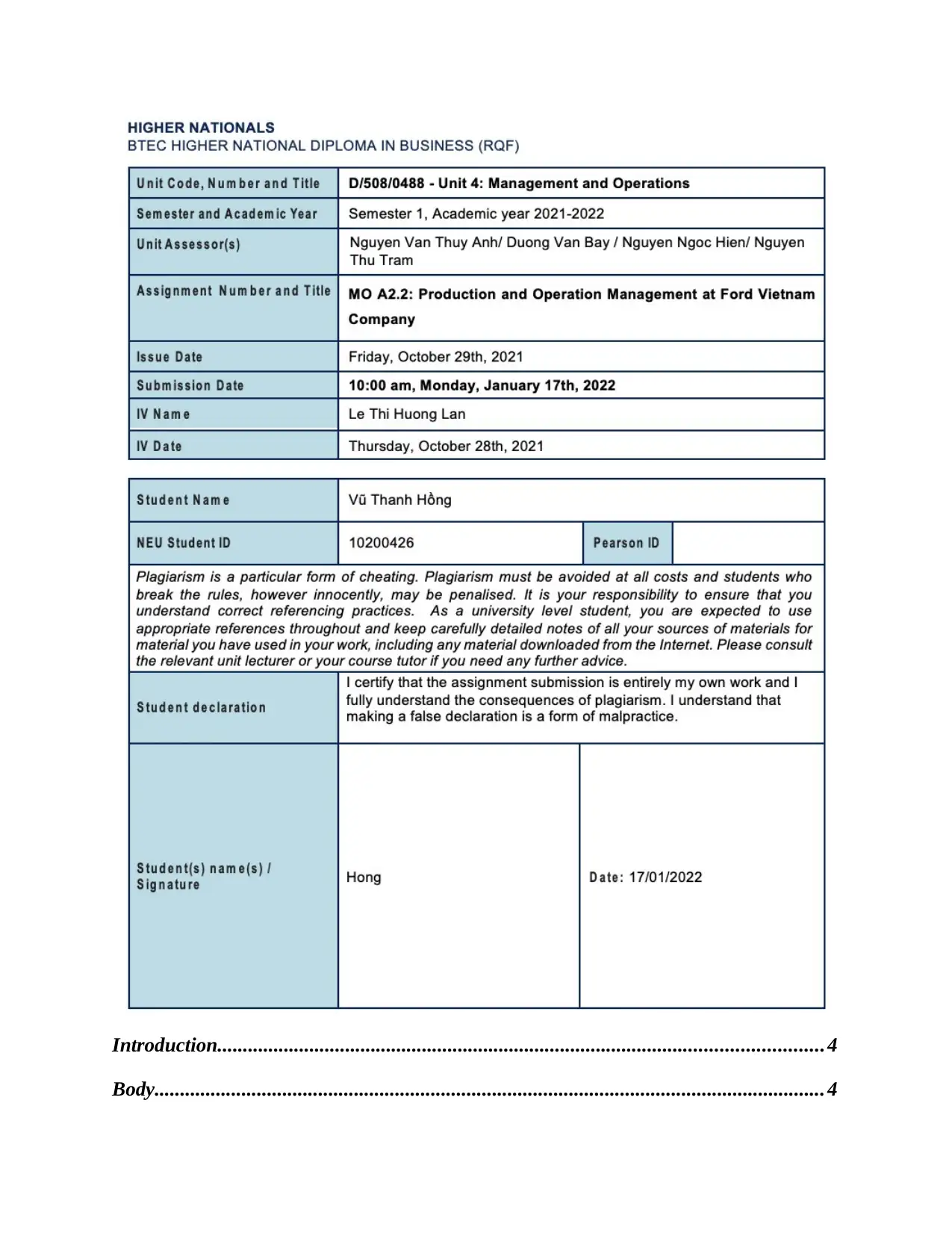
Introduction...................................................................................................................... 4
Body................................................................................................................................... 4
Body................................................................................................................................... 4
Paraphrase This Document
Need a fresh take? Get an instant paraphrase of this document with our AI Paraphraser
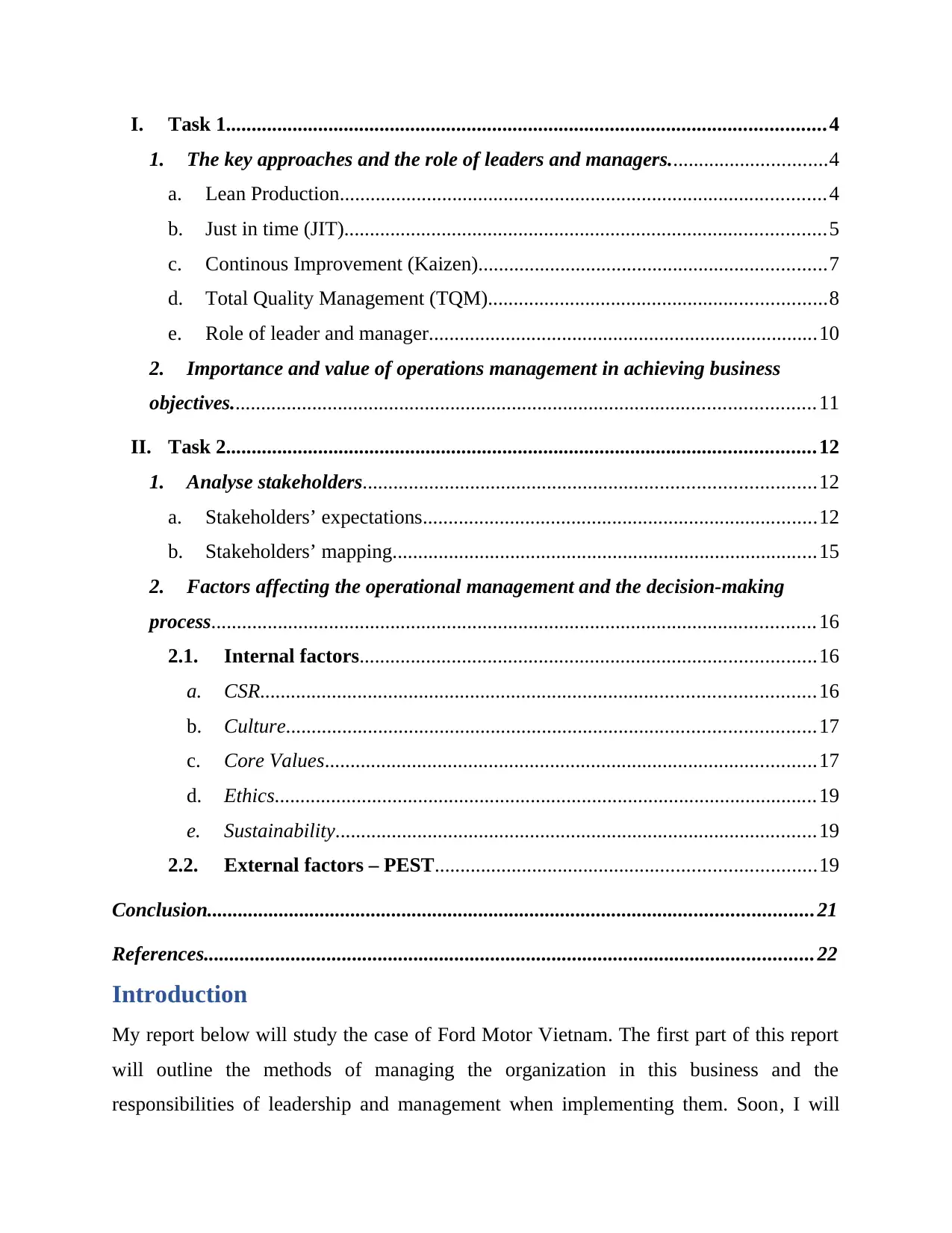
I. Task 1..................................................................................................................... 4
1. The key approaches and the role of leaders and managers...............................4
a. Lean Production...............................................................................................4
b. Just in time (JIT)..............................................................................................5
c. Continous Improvement (Kaizen)....................................................................7
d. Total Quality Management (TQM)..................................................................8
e. Role of leader and manager............................................................................10
2. Importance and value of operations management in achieving business
objectives..................................................................................................................11
II. Task 2................................................................................................................... 12
1. Analyse stakeholders........................................................................................12
a. Stakeholders’ expectations.............................................................................12
b. Stakeholders’ mapping...................................................................................15
2. Factors affecting the operational management and the decision-making
process...................................................................................................................... 16
2.1. Internal factors.........................................................................................16
a. CSR............................................................................................................16
b. Culture.......................................................................................................17
c. Core Values................................................................................................17
d. Ethics..........................................................................................................19
e. Sustainability..............................................................................................19
2.2. External factors – PEST..........................................................................19
Conclusion...................................................................................................................... 21
References....................................................................................................................... 22
Introduction
My report below will study the case of Ford Motor Vietnam. The first part of this report
will outline the methods of managing the organization in this business and the
responsibilities of leadership and management when implementing them. Soon, I will
1. The key approaches and the role of leaders and managers...............................4
a. Lean Production...............................................................................................4
b. Just in time (JIT)..............................................................................................5
c. Continous Improvement (Kaizen)....................................................................7
d. Total Quality Management (TQM)..................................................................8
e. Role of leader and manager............................................................................10
2. Importance and value of operations management in achieving business
objectives..................................................................................................................11
II. Task 2................................................................................................................... 12
1. Analyse stakeholders........................................................................................12
a. Stakeholders’ expectations.............................................................................12
b. Stakeholders’ mapping...................................................................................15
2. Factors affecting the operational management and the decision-making
process...................................................................................................................... 16
2.1. Internal factors.........................................................................................16
a. CSR............................................................................................................16
b. Culture.......................................................................................................17
c. Core Values................................................................................................17
d. Ethics..........................................................................................................19
e. Sustainability..............................................................................................19
2.2. External factors – PEST..........................................................................19
Conclusion...................................................................................................................... 21
References....................................................................................................................... 22
Introduction
My report below will study the case of Ford Motor Vietnam. The first part of this report
will outline the methods of managing the organization in this business and the
responsibilities of leadership and management when implementing them. Soon, I will
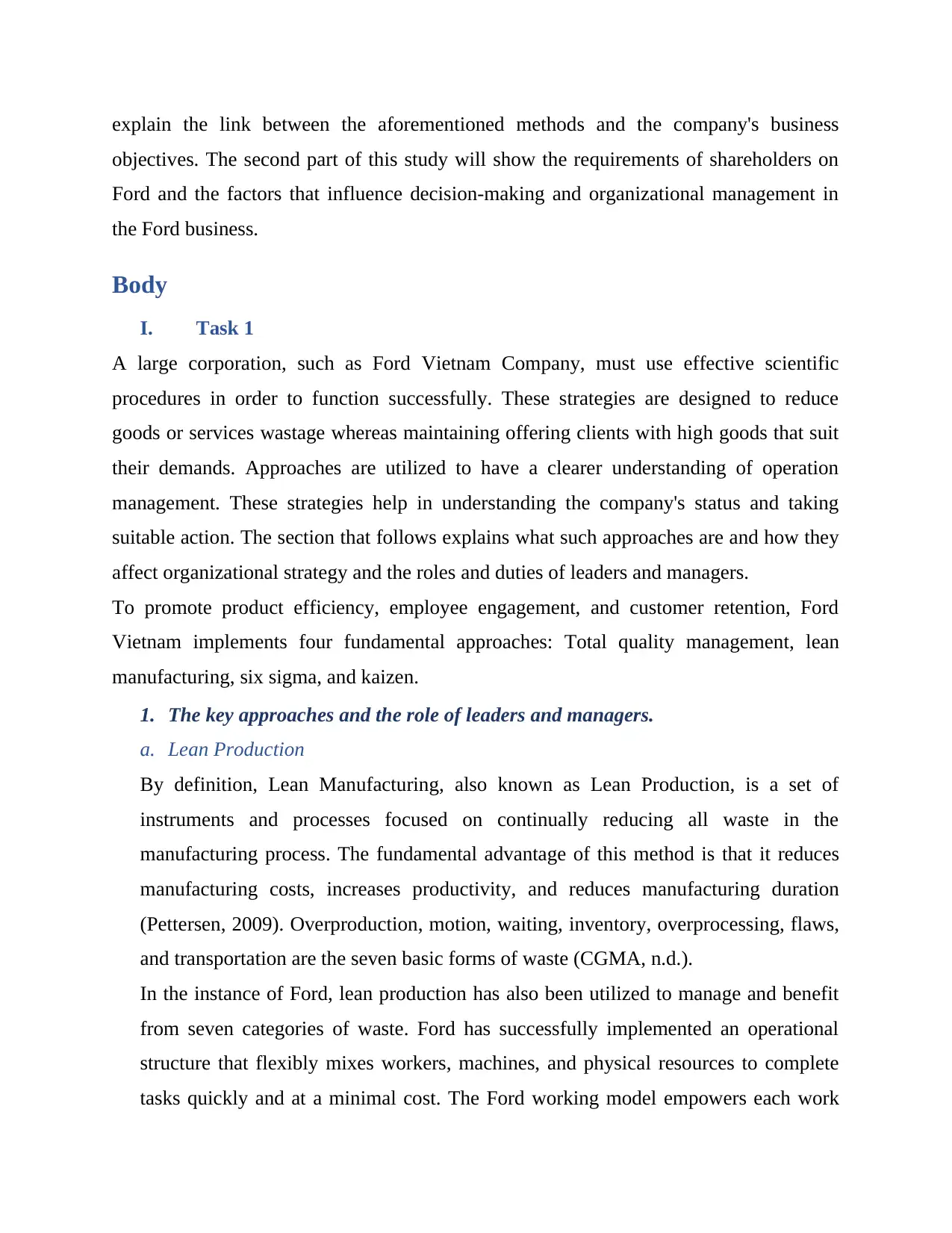
explain the link between the aforementioned methods and the company's business
objectives. The second part of this study will show the requirements of shareholders on
Ford and the factors that influence decision-making and organizational management in
the Ford business.
Body
I. Task 1
A large corporation, such as Ford Vietnam Company, must use effective scientific
procedures in order to function successfully. These strategies are designed to reduce
goods or services wastage whereas maintaining offering clients with high goods that suit
their demands. Approaches are utilized to have a clearer understanding of operation
management. These strategies help in understanding the company's status and taking
suitable action. The section that follows explains what such approaches are and how they
affect organizational strategy and the roles and duties of leaders and managers.
To promote product efficiency, employee engagement, and customer retention, Ford
Vietnam implements four fundamental approaches: Total quality management, lean
manufacturing, six sigma, and kaizen.
1. The key approaches and the role of leaders and managers.
a. Lean Production
By definition, Lean Manufacturing, also known as Lean Production, is a set of
instruments and processes focused on continually reducing all waste in the
manufacturing process. The fundamental advantage of this method is that it reduces
manufacturing costs, increases productivity, and reduces manufacturing duration
(Pettersen, 2009). Overproduction, motion, waiting, inventory, overprocessing, flaws,
and transportation are the seven basic forms of waste (CGMA, n.d.).
In the instance of Ford, lean production has also been utilized to manage and benefit
from seven categories of waste. Ford has successfully implemented an operational
structure that flexibly mixes workers, machines, and physical resources to complete
tasks quickly and at a minimal cost. The Ford working model empowers each work
objectives. The second part of this study will show the requirements of shareholders on
Ford and the factors that influence decision-making and organizational management in
the Ford business.
Body
I. Task 1
A large corporation, such as Ford Vietnam Company, must use effective scientific
procedures in order to function successfully. These strategies are designed to reduce
goods or services wastage whereas maintaining offering clients with high goods that suit
their demands. Approaches are utilized to have a clearer understanding of operation
management. These strategies help in understanding the company's status and taking
suitable action. The section that follows explains what such approaches are and how they
affect organizational strategy and the roles and duties of leaders and managers.
To promote product efficiency, employee engagement, and customer retention, Ford
Vietnam implements four fundamental approaches: Total quality management, lean
manufacturing, six sigma, and kaizen.
1. The key approaches and the role of leaders and managers.
a. Lean Production
By definition, Lean Manufacturing, also known as Lean Production, is a set of
instruments and processes focused on continually reducing all waste in the
manufacturing process. The fundamental advantage of this method is that it reduces
manufacturing costs, increases productivity, and reduces manufacturing duration
(Pettersen, 2009). Overproduction, motion, waiting, inventory, overprocessing, flaws,
and transportation are the seven basic forms of waste (CGMA, n.d.).
In the instance of Ford, lean production has also been utilized to manage and benefit
from seven categories of waste. Ford has successfully implemented an operational
structure that flexibly mixes workers, machines, and physical resources to complete
tasks quickly and at a minimal cost. The Ford working model empowers each work
⊘ This is a preview!⊘
Do you want full access?
Subscribe today to unlock all pages.

Trusted by 1+ million students worldwide
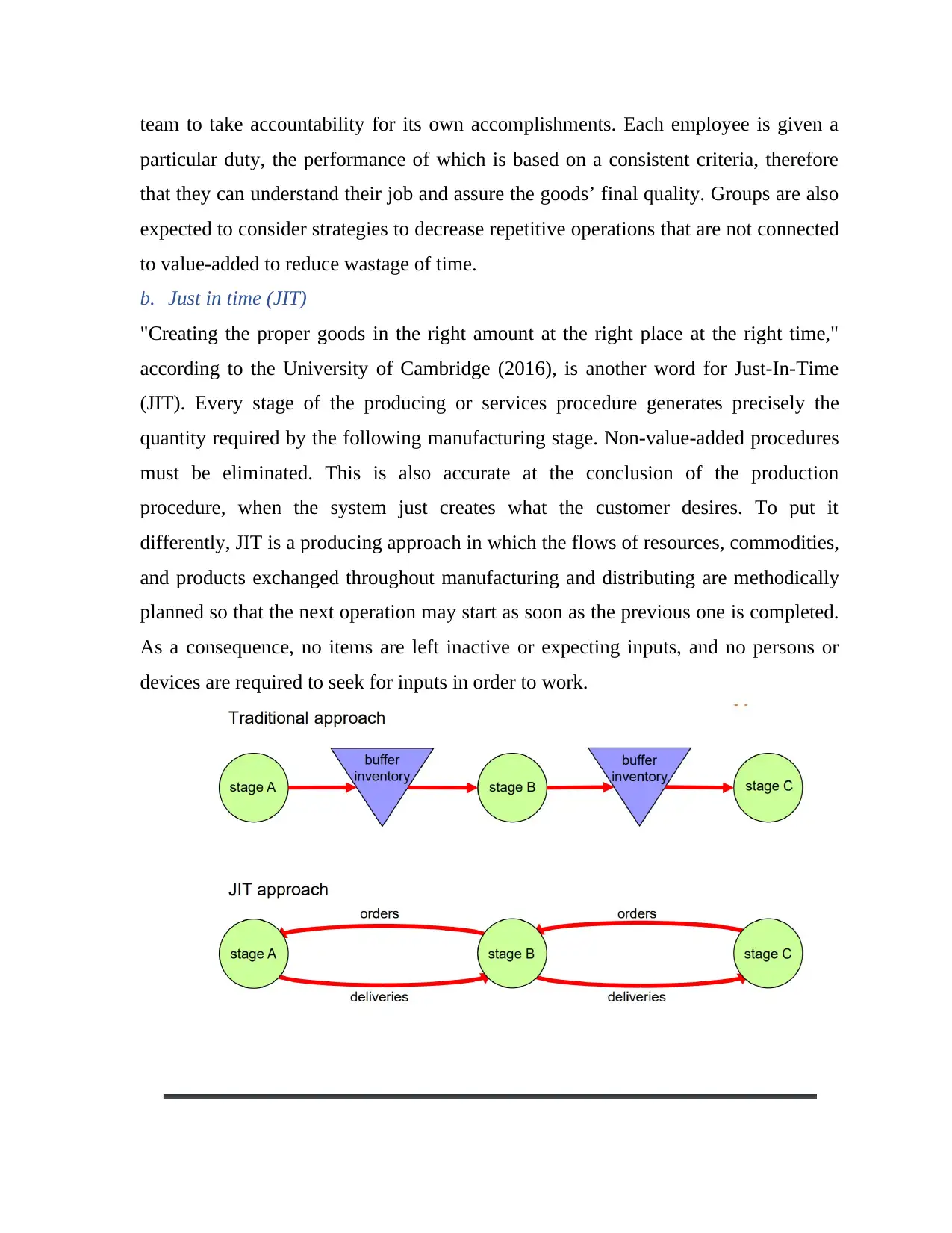
team to take accountability for its own accomplishments. Each employee is given a
particular duty, the performance of which is based on a consistent criteria, therefore
that they can understand their job and assure the goods’ final quality. Groups are also
expected to consider strategies to decrease repetitive operations that are not connected
to value-added to reduce wastage of time.
b. Just in time (JIT)
"Creating the proper goods in the right amount at the right place at the right time,"
according to the University of Cambridge (2016), is another word for Just-In-Time
(JIT). Every stage of the producing or services procedure generates precisely the
quantity required by the following manufacturing stage. Non-value-added procedures
must be eliminated. This is also accurate at the conclusion of the production
procedure, when the system just creates what the customer desires. To put it
differently, JIT is a producing approach in which the flows of resources, commodities,
and products exchanged throughout manufacturing and distributing are methodically
planned so that the next operation may start as soon as the previous one is completed.
As a consequence, no items are left inactive or expecting inputs, and no persons or
devices are required to seek for inputs in order to work.
particular duty, the performance of which is based on a consistent criteria, therefore
that they can understand their job and assure the goods’ final quality. Groups are also
expected to consider strategies to decrease repetitive operations that are not connected
to value-added to reduce wastage of time.
b. Just in time (JIT)
"Creating the proper goods in the right amount at the right place at the right time,"
according to the University of Cambridge (2016), is another word for Just-In-Time
(JIT). Every stage of the producing or services procedure generates precisely the
quantity required by the following manufacturing stage. Non-value-added procedures
must be eliminated. This is also accurate at the conclusion of the production
procedure, when the system just creates what the customer desires. To put it
differently, JIT is a producing approach in which the flows of resources, commodities,
and products exchanged throughout manufacturing and distributing are methodically
planned so that the next operation may start as soon as the previous one is completed.
As a consequence, no items are left inactive or expecting inputs, and no persons or
devices are required to seek for inputs in order to work.
Paraphrase This Document
Need a fresh take? Get an instant paraphrase of this document with our AI Paraphraser
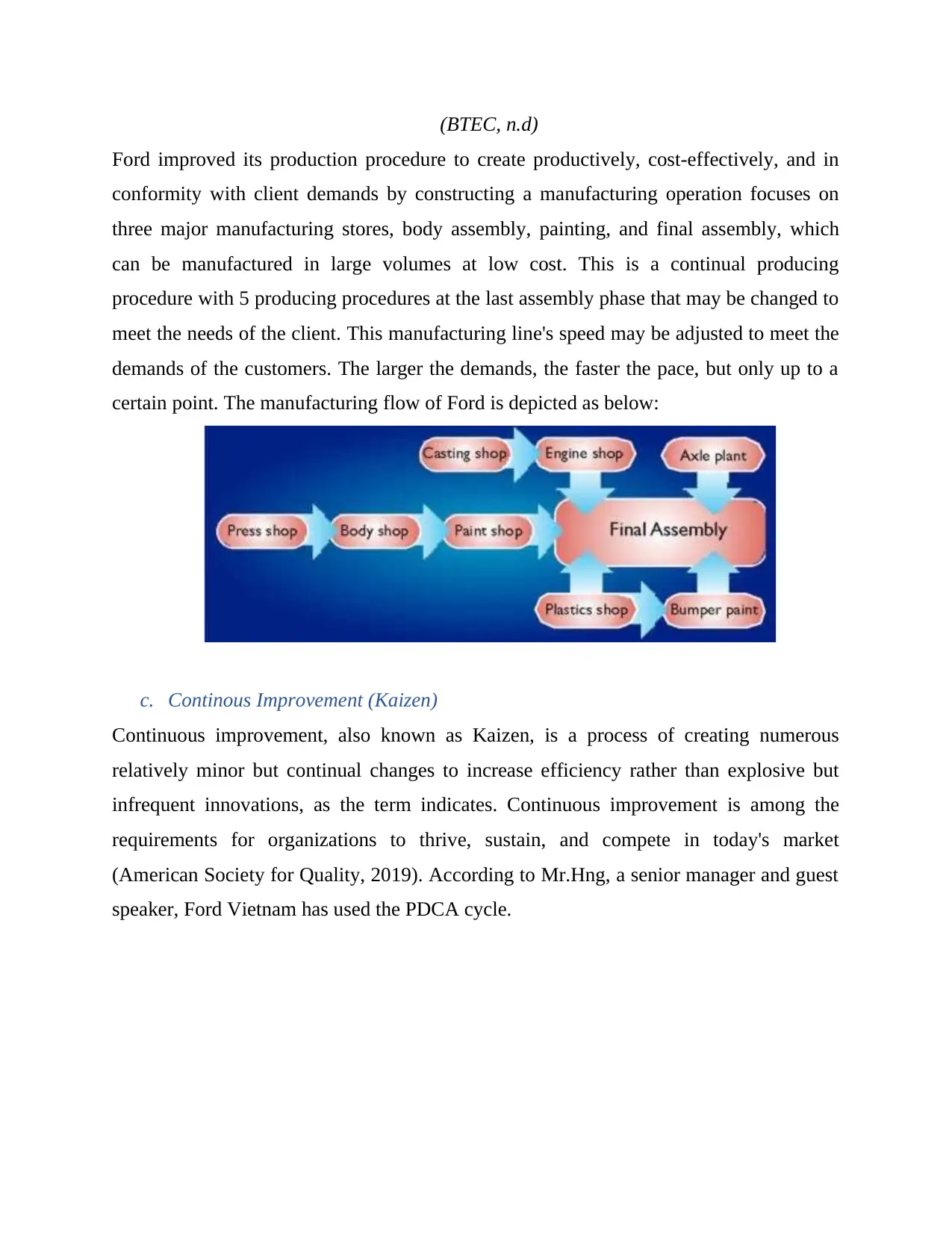
(BTEC, n.d)
Ford improved its production procedure to create productively, cost-effectively, and in
conformity with client demands by constructing a manufacturing operation focuses on
three major manufacturing stores, body assembly, painting, and final assembly, which
can be manufactured in large volumes at low cost. This is a continual producing
procedure with 5 producing procedures at the last assembly phase that may be changed to
meet the needs of the client. This manufacturing line's speed may be adjusted to meet the
demands of the customers. The larger the demands, the faster the pace, but only up to a
certain point. The manufacturing flow of Ford is depicted as below:
c. Continous Improvement (Kaizen)
Continuous improvement, also known as Kaizen, is a process of creating numerous
relatively minor but continual changes to increase efficiency rather than explosive but
infrequent innovations, as the term indicates. Continuous improvement is among the
requirements for organizations to thrive, sustain, and compete in today's market
(American Society for Quality, 2019). According to Mr.Hng, a senior manager and guest
speaker, Ford Vietnam has used the PDCA cycle.
Ford improved its production procedure to create productively, cost-effectively, and in
conformity with client demands by constructing a manufacturing operation focuses on
three major manufacturing stores, body assembly, painting, and final assembly, which
can be manufactured in large volumes at low cost. This is a continual producing
procedure with 5 producing procedures at the last assembly phase that may be changed to
meet the needs of the client. This manufacturing line's speed may be adjusted to meet the
demands of the customers. The larger the demands, the faster the pace, but only up to a
certain point. The manufacturing flow of Ford is depicted as below:
c. Continous Improvement (Kaizen)
Continuous improvement, also known as Kaizen, is a process of creating numerous
relatively minor but continual changes to increase efficiency rather than explosive but
infrequent innovations, as the term indicates. Continuous improvement is among the
requirements for organizations to thrive, sustain, and compete in today's market
(American Society for Quality, 2019). According to Mr.Hng, a senior manager and guest
speaker, Ford Vietnam has used the PDCA cycle.
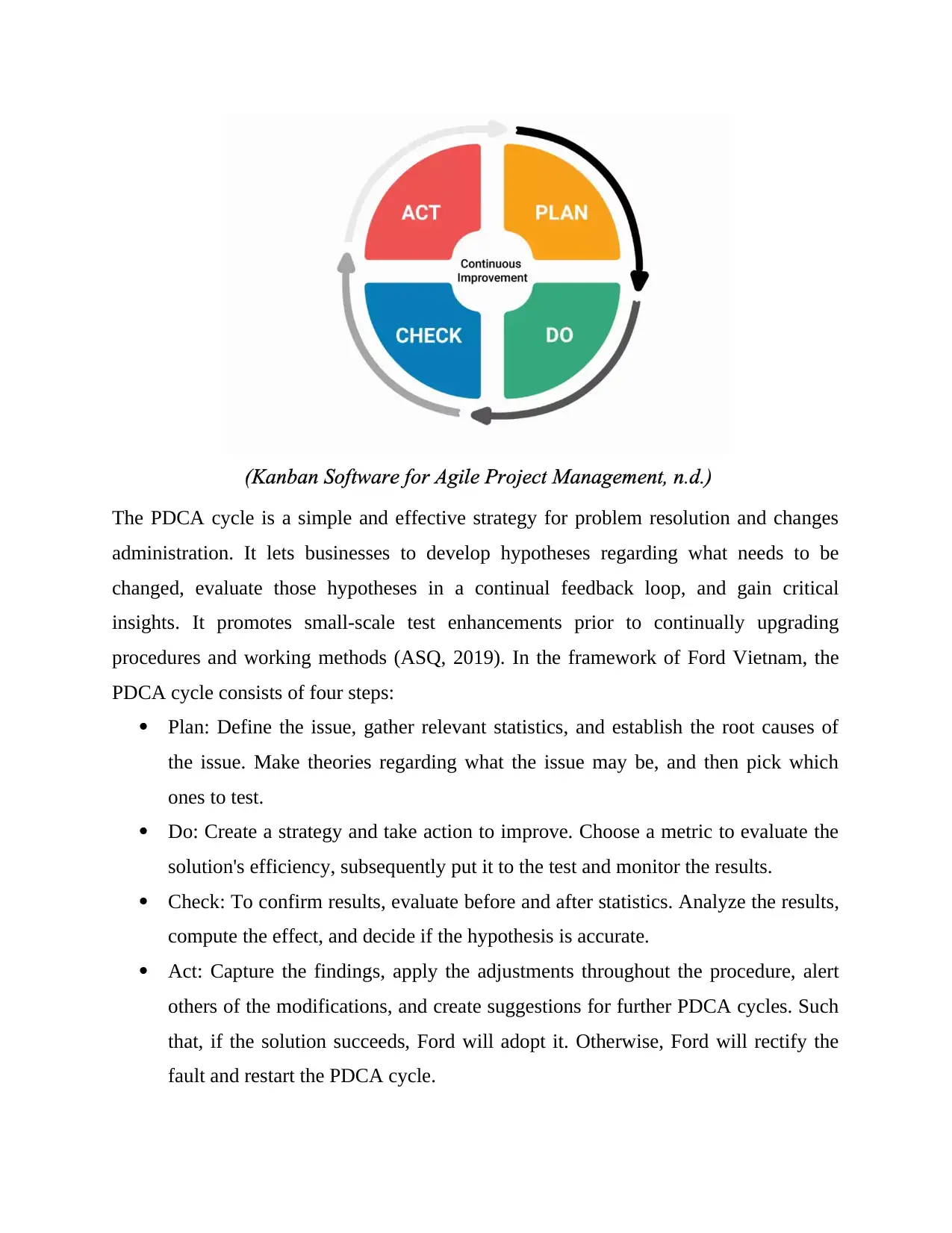
The PDCA cycle is a simple and effective strategy for problem resolution and changes
administration. It lets businesses to develop hypotheses regarding what needs to be
changed, evaluate those hypotheses in a continual feedback loop, and gain critical
insights. It promotes small-scale test enhancements prior to continually upgrading
procedures and working methods (ASQ, 2019). In the framework of Ford Vietnam, the
PDCA cycle consists of four steps:
Plan: Define the issue, gather relevant statistics, and establish the root causes of
the issue. Make theories regarding what the issue may be, and then pick which
ones to test.
Do: Create a strategy and take action to improve. Choose a metric to evaluate the
solution's efficiency, subsequently put it to the test and monitor the results.
Check: To confirm results, evaluate before and after statistics. Analyze the results,
compute the effect, and decide if the hypothesis is accurate.
Act: Capture the findings, apply the adjustments throughout the procedure, alert
others of the modifications, and create suggestions for further PDCA cycles. Such
that, if the solution succeeds, Ford will adopt it. Otherwise, Ford will rectify the
fault and restart the PDCA cycle.
administration. It lets businesses to develop hypotheses regarding what needs to be
changed, evaluate those hypotheses in a continual feedback loop, and gain critical
insights. It promotes small-scale test enhancements prior to continually upgrading
procedures and working methods (ASQ, 2019). In the framework of Ford Vietnam, the
PDCA cycle consists of four steps:
Plan: Define the issue, gather relevant statistics, and establish the root causes of
the issue. Make theories regarding what the issue may be, and then pick which
ones to test.
Do: Create a strategy and take action to improve. Choose a metric to evaluate the
solution's efficiency, subsequently put it to the test and monitor the results.
Check: To confirm results, evaluate before and after statistics. Analyze the results,
compute the effect, and decide if the hypothesis is accurate.
Act: Capture the findings, apply the adjustments throughout the procedure, alert
others of the modifications, and create suggestions for further PDCA cycles. Such
that, if the solution succeeds, Ford will adopt it. Otherwise, Ford will rectify the
fault and restart the PDCA cycle.
⊘ This is a preview!⊘
Do you want full access?
Subscribe today to unlock all pages.

Trusted by 1+ million students worldwide
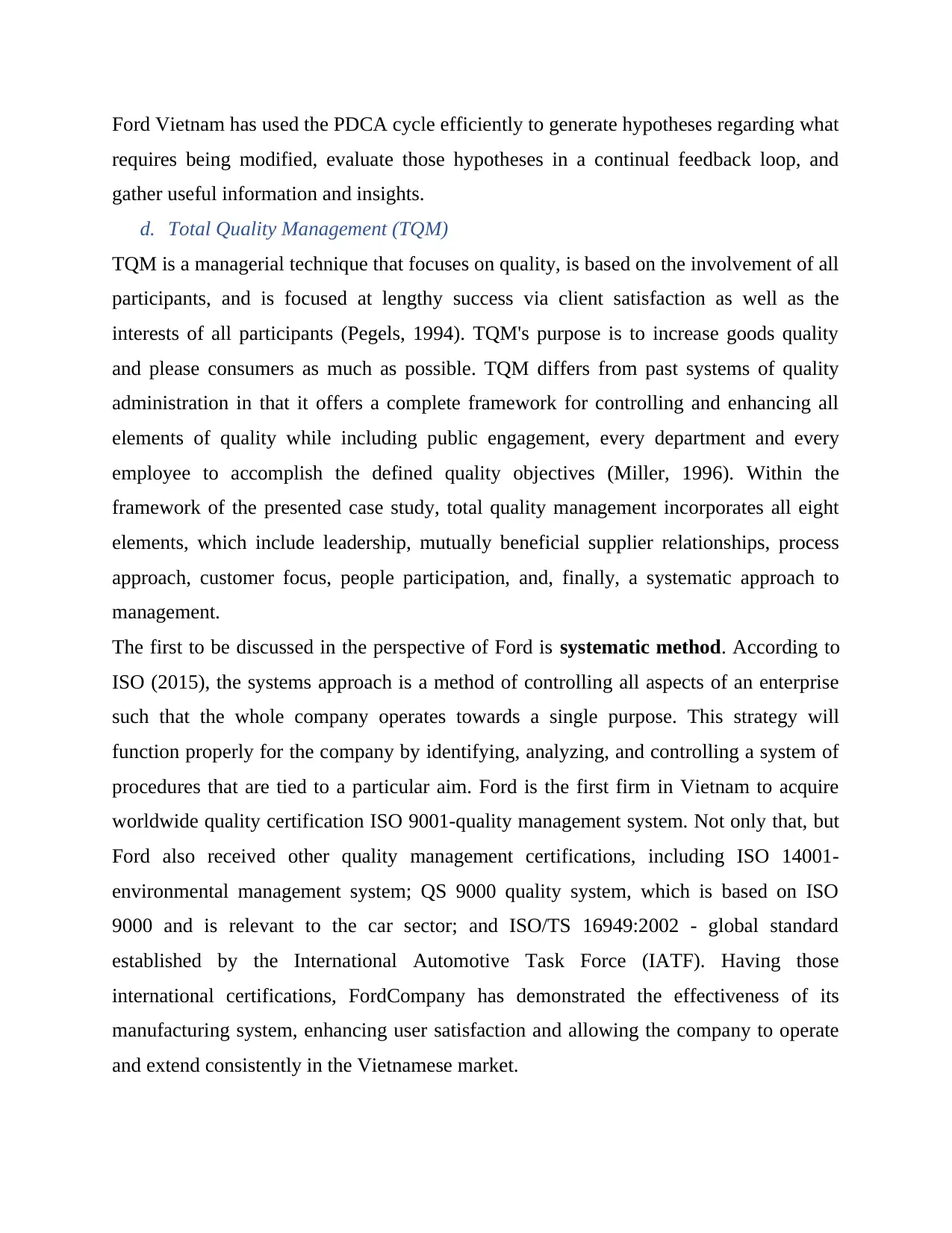
Ford Vietnam has used the PDCA cycle efficiently to generate hypotheses regarding what
requires being modified, evaluate those hypotheses in a continual feedback loop, and
gather useful information and insights.
d. Total Quality Management (TQM)
TQM is a managerial technique that focuses on quality, is based on the involvement of all
participants, and is focused at lengthy success via client satisfaction as well as the
interests of all participants (Pegels, 1994). TQM's purpose is to increase goods quality
and please consumers as much as possible. TQM differs from past systems of quality
administration in that it offers a complete framework for controlling and enhancing all
elements of quality while including public engagement, every department and every
employee to accomplish the defined quality objectives (Miller, 1996). Within the
framework of the presented case study, total quality management incorporates all eight
elements, which include leadership, mutually beneficial supplier relationships, process
approach, customer focus, people participation, and, finally, a systematic approach to
management.
The first to be discussed in the perspective of Ford is systematic method. According to
ISO (2015), the systems approach is a method of controlling all aspects of an enterprise
such that the whole company operates towards a single purpose. This strategy will
function properly for the company by identifying, analyzing, and controlling a system of
procedures that are tied to a particular aim. Ford is the first firm in Vietnam to acquire
worldwide quality certification ISO 9001-quality management system. Not only that, but
Ford also received other quality management certifications, including ISO 14001-
environmental management system; QS 9000 quality system, which is based on ISO
9000 and is relevant to the car sector; and ISO/TS 16949:2002 - global standard
established by the International Automotive Task Force (IATF). Having those
international certifications, FordCompany has demonstrated the effectiveness of its
manufacturing system, enhancing user satisfaction and allowing the company to operate
and extend consistently in the Vietnamese market.
requires being modified, evaluate those hypotheses in a continual feedback loop, and
gather useful information and insights.
d. Total Quality Management (TQM)
TQM is a managerial technique that focuses on quality, is based on the involvement of all
participants, and is focused at lengthy success via client satisfaction as well as the
interests of all participants (Pegels, 1994). TQM's purpose is to increase goods quality
and please consumers as much as possible. TQM differs from past systems of quality
administration in that it offers a complete framework for controlling and enhancing all
elements of quality while including public engagement, every department and every
employee to accomplish the defined quality objectives (Miller, 1996). Within the
framework of the presented case study, total quality management incorporates all eight
elements, which include leadership, mutually beneficial supplier relationships, process
approach, customer focus, people participation, and, finally, a systematic approach to
management.
The first to be discussed in the perspective of Ford is systematic method. According to
ISO (2015), the systems approach is a method of controlling all aspects of an enterprise
such that the whole company operates towards a single purpose. This strategy will
function properly for the company by identifying, analyzing, and controlling a system of
procedures that are tied to a particular aim. Ford is the first firm in Vietnam to acquire
worldwide quality certification ISO 9001-quality management system. Not only that, but
Ford also received other quality management certifications, including ISO 14001-
environmental management system; QS 9000 quality system, which is based on ISO
9000 and is relevant to the car sector; and ISO/TS 16949:2002 - global standard
established by the International Automotive Task Force (IATF). Having those
international certifications, FordCompany has demonstrated the effectiveness of its
manufacturing system, enhancing user satisfaction and allowing the company to operate
and extend consistently in the Vietnamese market.
Paraphrase This Document
Need a fresh take? Get an instant paraphrase of this document with our AI Paraphraser
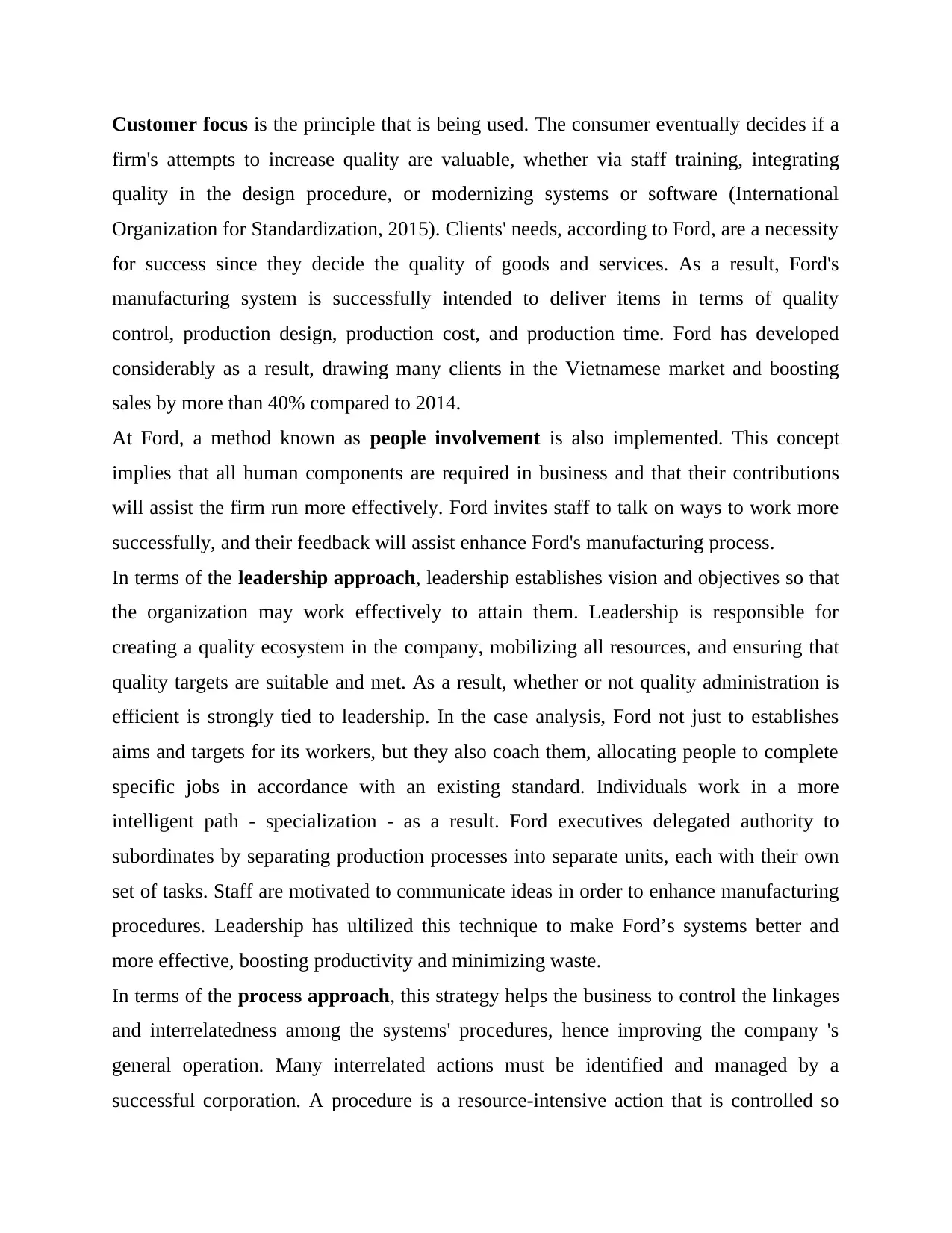
Customer focus is the principle that is being used. The consumer eventually decides if a
firm's attempts to increase quality are valuable, whether via staff training, integrating
quality in the design procedure, or modernizing systems or software (International
Organization for Standardization, 2015). Clients' needs, according to Ford, are a necessity
for success since they decide the quality of goods and services. As a result, Ford's
manufacturing system is successfully intended to deliver items in terms of quality
control, production design, production cost, and production time. Ford has developed
considerably as a result, drawing many clients in the Vietnamese market and boosting
sales by more than 40% compared to 2014.
At Ford, a method known as people involvement is also implemented. This concept
implies that all human components are required in business and that their contributions
will assist the firm run more effectively. Ford invites staff to talk on ways to work more
successfully, and their feedback will assist enhance Ford's manufacturing process.
In terms of the leadership approach, leadership establishes vision and objectives so that
the organization may work effectively to attain them. Leadership is responsible for
creating a quality ecosystem in the company, mobilizing all resources, and ensuring that
quality targets are suitable and met. As a result, whether or not quality administration is
efficient is strongly tied to leadership. In the case analysis, Ford not just to establishes
aims and targets for its workers, but they also coach them, allocating people to complete
specific jobs in accordance with an existing standard. Individuals work in a more
intelligent path - specialization - as a result. Ford executives delegated authority to
subordinates by separating production processes into separate units, each with their own
set of tasks. Staff are motivated to communicate ideas in order to enhance manufacturing
procedures. Leadership has ultilized this technique to make Ford’s systems better and
more effective, boosting productivity and minimizing waste.
In terms of the process approach, this strategy helps the business to control the linkages
and interrelatedness among the systems' procedures, hence improving the company 's
general operation. Many interrelated actions must be identified and managed by a
successful corporation. A procedure is a resource-intensive action that is controlled so
firm's attempts to increase quality are valuable, whether via staff training, integrating
quality in the design procedure, or modernizing systems or software (International
Organization for Standardization, 2015). Clients' needs, according to Ford, are a necessity
for success since they decide the quality of goods and services. As a result, Ford's
manufacturing system is successfully intended to deliver items in terms of quality
control, production design, production cost, and production time. Ford has developed
considerably as a result, drawing many clients in the Vietnamese market and boosting
sales by more than 40% compared to 2014.
At Ford, a method known as people involvement is also implemented. This concept
implies that all human components are required in business and that their contributions
will assist the firm run more effectively. Ford invites staff to talk on ways to work more
successfully, and their feedback will assist enhance Ford's manufacturing process.
In terms of the leadership approach, leadership establishes vision and objectives so that
the organization may work effectively to attain them. Leadership is responsible for
creating a quality ecosystem in the company, mobilizing all resources, and ensuring that
quality targets are suitable and met. As a result, whether or not quality administration is
efficient is strongly tied to leadership. In the case analysis, Ford not just to establishes
aims and targets for its workers, but they also coach them, allocating people to complete
specific jobs in accordance with an existing standard. Individuals work in a more
intelligent path - specialization - as a result. Ford executives delegated authority to
subordinates by separating production processes into separate units, each with their own
set of tasks. Staff are motivated to communicate ideas in order to enhance manufacturing
procedures. Leadership has ultilized this technique to make Ford’s systems better and
more effective, boosting productivity and minimizing waste.
In terms of the process approach, this strategy helps the business to control the linkages
and interrelatedness among the systems' procedures, hence improving the company 's
general operation. Many interrelated actions must be identified and managed by a
successful corporation. A procedure is a resource-intensive action that is controlled so
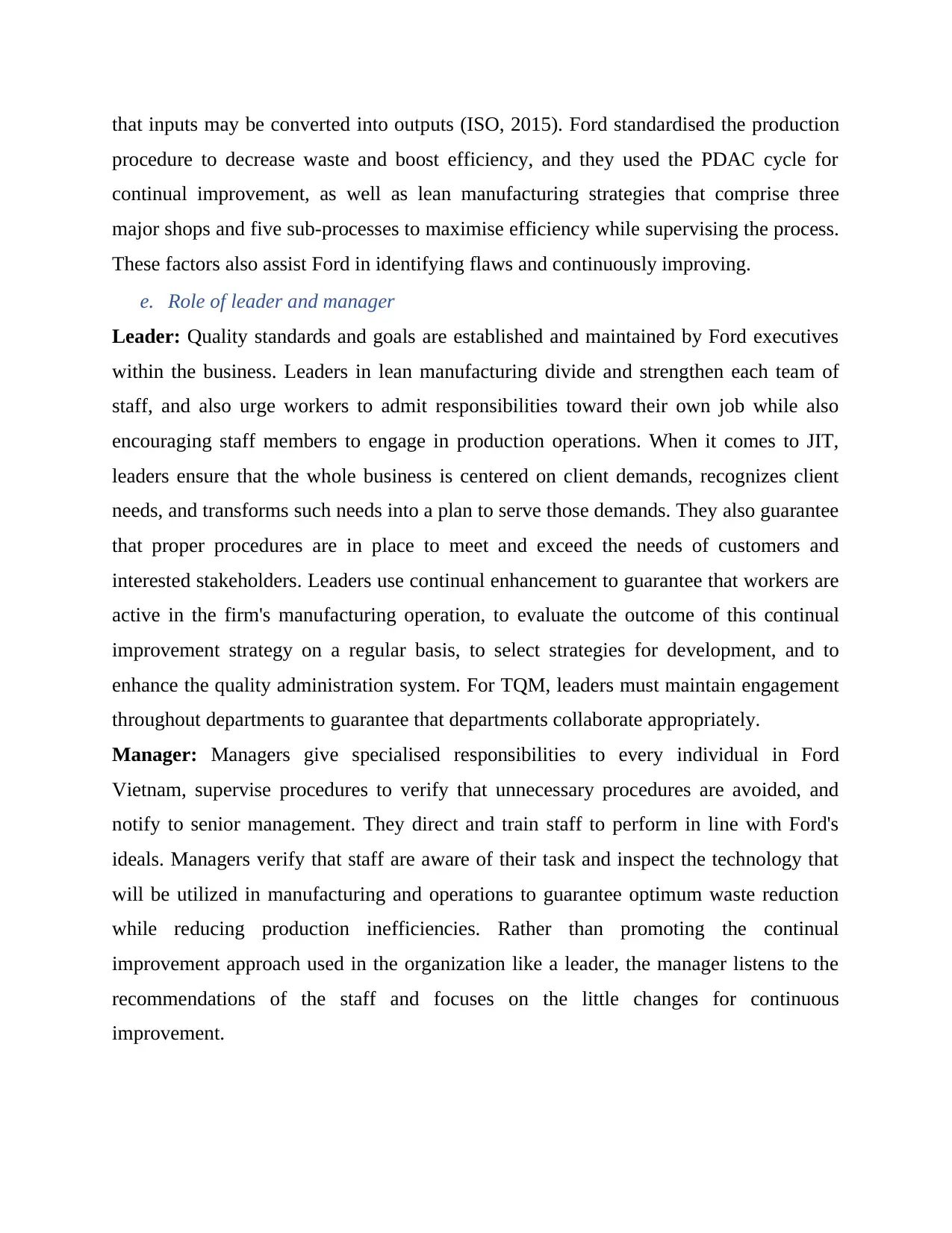
that inputs may be converted into outputs (ISO, 2015). Ford standardised the production
procedure to decrease waste and boost efficiency, and they used the PDAC cycle for
continual improvement, as well as lean manufacturing strategies that comprise three
major shops and five sub-processes to maximise efficiency while supervising the process.
These factors also assist Ford in identifying flaws and continuously improving.
e. Role of leader and manager
Leader: Quality standards and goals are established and maintained by Ford executives
within the business. Leaders in lean manufacturing divide and strengthen each team of
staff, and also urge workers to admit responsibilities toward their own job while also
encouraging staff members to engage in production operations. When it comes to JIT,
leaders ensure that the whole business is centered on client demands, recognizes client
needs, and transforms such needs into a plan to serve those demands. They also guarantee
that proper procedures are in place to meet and exceed the needs of customers and
interested stakeholders. Leaders use continual enhancement to guarantee that workers are
active in the firm's manufacturing operation, to evaluate the outcome of this continual
improvement strategy on a regular basis, to select strategies for development, and to
enhance the quality administration system. For TQM, leaders must maintain engagement
throughout departments to guarantee that departments collaborate appropriately.
Manager: Managers give specialised responsibilities to every individual in Ford
Vietnam, supervise procedures to verify that unnecessary procedures are avoided, and
notify to senior management. They direct and train staff to perform in line with Ford's
ideals. Managers verify that staff are aware of their task and inspect the technology that
will be utilized in manufacturing and operations to guarantee optimum waste reduction
while reducing production inefficiencies. Rather than promoting the continual
improvement approach used in the organization like a leader, the manager listens to the
recommendations of the staff and focuses on the little changes for continuous
improvement.
procedure to decrease waste and boost efficiency, and they used the PDAC cycle for
continual improvement, as well as lean manufacturing strategies that comprise three
major shops and five sub-processes to maximise efficiency while supervising the process.
These factors also assist Ford in identifying flaws and continuously improving.
e. Role of leader and manager
Leader: Quality standards and goals are established and maintained by Ford executives
within the business. Leaders in lean manufacturing divide and strengthen each team of
staff, and also urge workers to admit responsibilities toward their own job while also
encouraging staff members to engage in production operations. When it comes to JIT,
leaders ensure that the whole business is centered on client demands, recognizes client
needs, and transforms such needs into a plan to serve those demands. They also guarantee
that proper procedures are in place to meet and exceed the needs of customers and
interested stakeholders. Leaders use continual enhancement to guarantee that workers are
active in the firm's manufacturing operation, to evaluate the outcome of this continual
improvement strategy on a regular basis, to select strategies for development, and to
enhance the quality administration system. For TQM, leaders must maintain engagement
throughout departments to guarantee that departments collaborate appropriately.
Manager: Managers give specialised responsibilities to every individual in Ford
Vietnam, supervise procedures to verify that unnecessary procedures are avoided, and
notify to senior management. They direct and train staff to perform in line with Ford's
ideals. Managers verify that staff are aware of their task and inspect the technology that
will be utilized in manufacturing and operations to guarantee optimum waste reduction
while reducing production inefficiencies. Rather than promoting the continual
improvement approach used in the organization like a leader, the manager listens to the
recommendations of the staff and focuses on the little changes for continuous
improvement.
⊘ This is a preview!⊘
Do you want full access?
Subscribe today to unlock all pages.

Trusted by 1+ million students worldwide
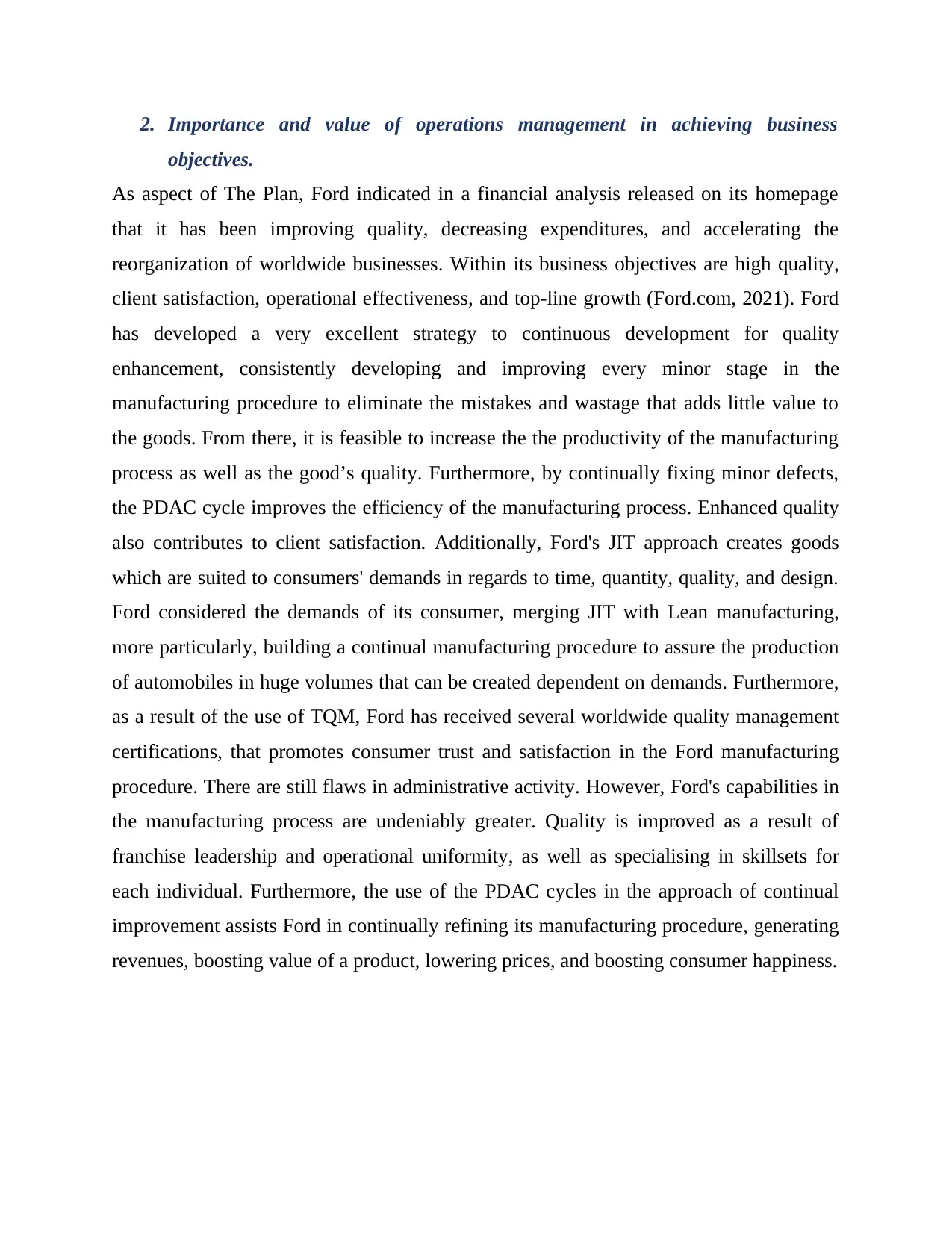
2. Importance and value of operations management in achieving business
objectives.
As aspect of The Plan, Ford indicated in a financial analysis released on its homepage
that it has been improving quality, decreasing expenditures, and accelerating the
reorganization of worldwide businesses. Within its business objectives are high quality,
client satisfaction, operational effectiveness, and top-line growth (Ford.com, 2021). Ford
has developed a very excellent strategy to continuous development for quality
enhancement, consistently developing and improving every minor stage in the
manufacturing procedure to eliminate the mistakes and wastage that adds little value to
the goods. From there, it is feasible to increase the the productivity of the manufacturing
process as well as the good’s quality. Furthermore, by continually fixing minor defects,
the PDAC cycle improves the efficiency of the manufacturing process. Enhanced quality
also contributes to client satisfaction. Additionally, Ford's JIT approach creates goods
which are suited to consumers' demands in regards to time, quantity, quality, and design.
Ford considered the demands of its consumer, merging JIT with Lean manufacturing,
more particularly, building a continual manufacturing procedure to assure the production
of automobiles in huge volumes that can be created dependent on demands. Furthermore,
as a result of the use of TQM, Ford has received several worldwide quality management
certifications, that promotes consumer trust and satisfaction in the Ford manufacturing
procedure. There are still flaws in administrative activity. However, Ford's capabilities in
the manufacturing process are undeniably greater. Quality is improved as a result of
franchise leadership and operational uniformity, as well as specialising in skillsets for
each individual. Furthermore, the use of the PDAC cycles in the approach of continual
improvement assists Ford in continually refining its manufacturing procedure, generating
revenues, boosting value of a product, lowering prices, and boosting consumer happiness.
objectives.
As aspect of The Plan, Ford indicated in a financial analysis released on its homepage
that it has been improving quality, decreasing expenditures, and accelerating the
reorganization of worldwide businesses. Within its business objectives are high quality,
client satisfaction, operational effectiveness, and top-line growth (Ford.com, 2021). Ford
has developed a very excellent strategy to continuous development for quality
enhancement, consistently developing and improving every minor stage in the
manufacturing procedure to eliminate the mistakes and wastage that adds little value to
the goods. From there, it is feasible to increase the the productivity of the manufacturing
process as well as the good’s quality. Furthermore, by continually fixing minor defects,
the PDAC cycle improves the efficiency of the manufacturing process. Enhanced quality
also contributes to client satisfaction. Additionally, Ford's JIT approach creates goods
which are suited to consumers' demands in regards to time, quantity, quality, and design.
Ford considered the demands of its consumer, merging JIT with Lean manufacturing,
more particularly, building a continual manufacturing procedure to assure the production
of automobiles in huge volumes that can be created dependent on demands. Furthermore,
as a result of the use of TQM, Ford has received several worldwide quality management
certifications, that promotes consumer trust and satisfaction in the Ford manufacturing
procedure. There are still flaws in administrative activity. However, Ford's capabilities in
the manufacturing process are undeniably greater. Quality is improved as a result of
franchise leadership and operational uniformity, as well as specialising in skillsets for
each individual. Furthermore, the use of the PDAC cycles in the approach of continual
improvement assists Ford in continually refining its manufacturing procedure, generating
revenues, boosting value of a product, lowering prices, and boosting consumer happiness.
Paraphrase This Document
Need a fresh take? Get an instant paraphrase of this document with our AI Paraphraser
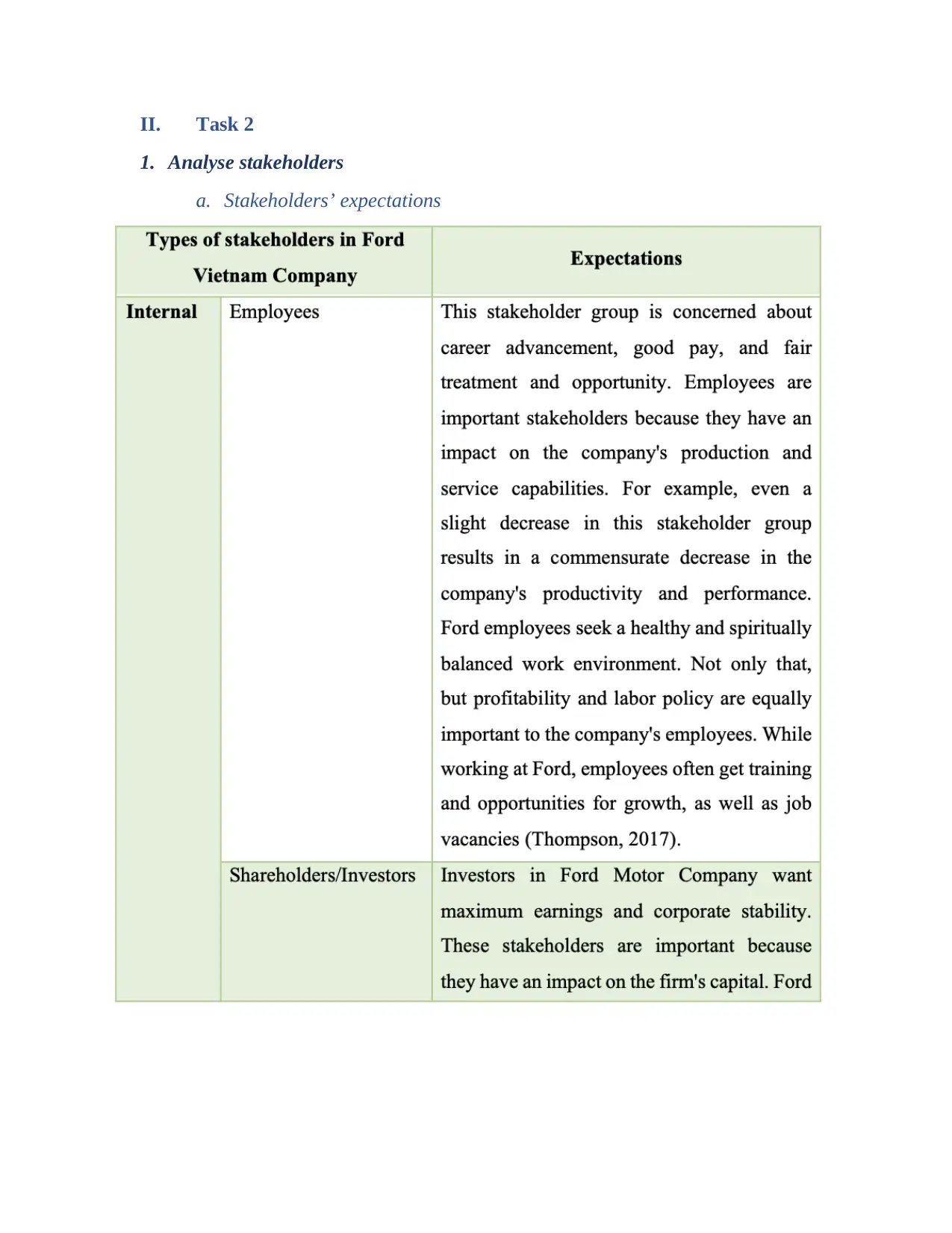
II. Task 2
1. Analyse stakeholders
a. Stakeholders’ expectations
1. Analyse stakeholders
a. Stakeholders’ expectations
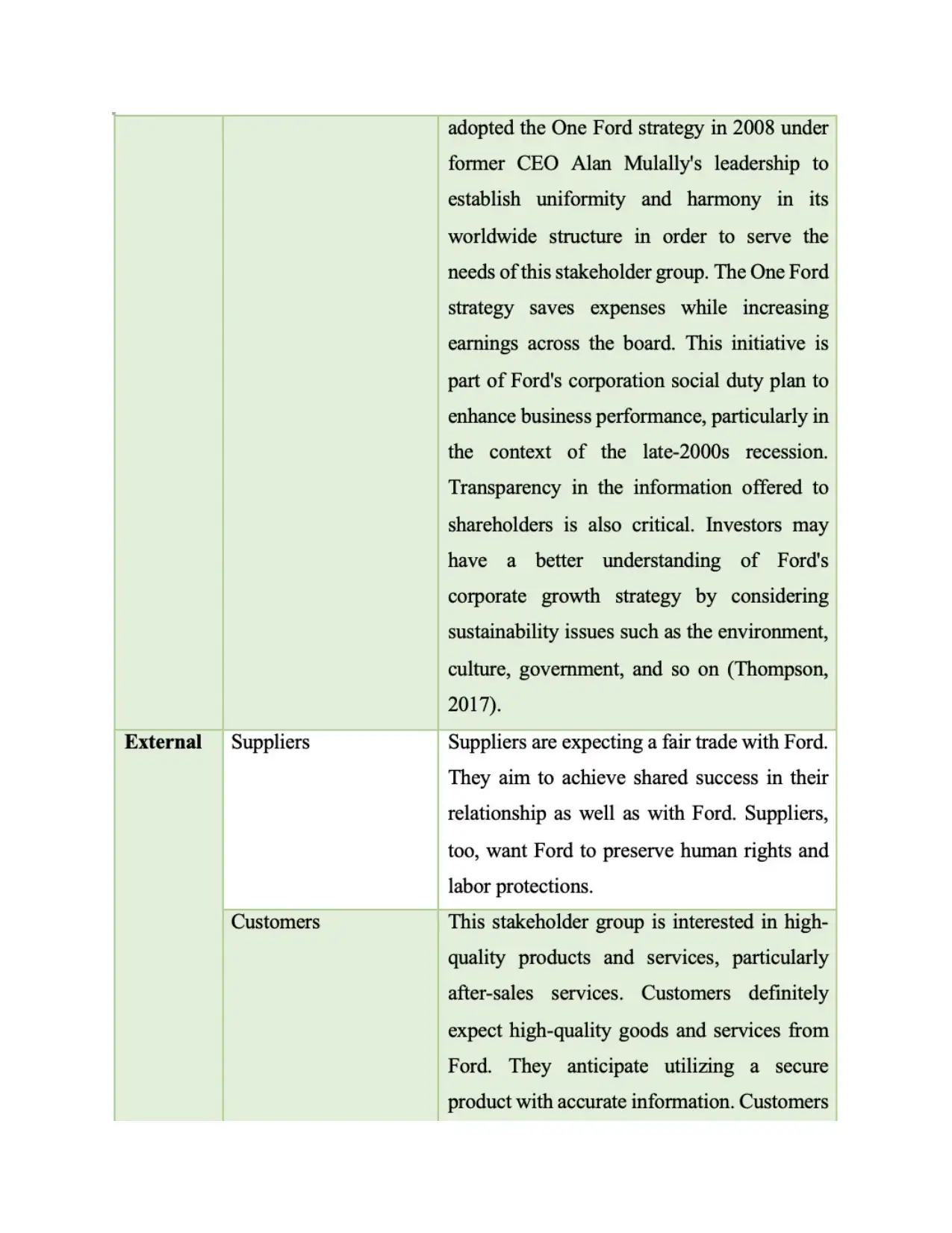
⊘ This is a preview!⊘
Do you want full access?
Subscribe today to unlock all pages.

Trusted by 1+ million students worldwide
1 out of 22
Related Documents
Your All-in-One AI-Powered Toolkit for Academic Success.
+13062052269
info@desklib.com
Available 24*7 on WhatsApp / Email
![[object Object]](/_next/static/media/star-bottom.7253800d.svg)
Unlock your academic potential
Copyright © 2020–2025 A2Z Services. All Rights Reserved. Developed and managed by ZUCOL.



